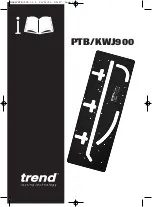
7
10
1. Lathe Bed
2. Tailstock
3. Tailstock Handwheel
4. Live Center
5. Tool Rest
6. Tool Rest Base
7. Spur Center
8. Headstock Cover
9. Headstock Handwheel
10. Headstock
11. Belt Access Cover Knob
12. Belt Access Cover
13. Motor Lifting Handle
14. Motor Locking Handle
15. Motor
16. On/Off Switch
BASIC COMPONENTS
10
9
8
7
6
5
4
3
1
14
13
11
12
16
15
2
Fig. 9
Fig. 11
Fig. 10
Fig. 12
Turning Tools
There are many types of turning tools on the market
today. The most common are High Speed Steel
turning tools. These can be organized into three
basic categories: gouges, scrapers and chisels
Fig 9
. Gouges can be used for a variety of cuts
from roughing out spindles to cutting out deep
hollows in bowls. Scrapers are commonly used for
general cutting purposes where a harder edge is
required or for finishing at very high speeds. Chisels
have sharp pointed edges and are very effective in
shear cutting and fine detail work but will dull more
quickly than scrapers. A selection of good quality
turning tools makes wood turning safer and more
enjoyable and should include tools from all
categories
Fig 10
.
Sharpening
Turning tools are commonly sharpened using a
bench grinder but are also sharpened with sanders
and hand held stones and honing pads. An 8"
bench grinder with a coarse and fine wheel
mounted on either side of the grinder is a common
bench grinder setup for woodturning
Fig 11
. Turning
tools can be supported by hand on adjustable
platforms or mounted into a grinding jig for
sharpening
Fig 12
. Grinder speed is a matter of
preference but 1750 RPM is the average speed
generally used for woodturning tools. Knowledge of
sharpening techniques will result in more effective
sharpening.
OPERATION
Many books, videos and workshops are
available on the subject of woodturning.
Before turning on this lathe, prior
experience in woodturning is
recommended. The information below is
presented as a brief overview of basic
woodturning procedures.
Caution
Gouges
Scrapers
Chisels
Turning Tools
143-009 MidiLathe (16) 9/28/07 11:16 AM Page 7

























